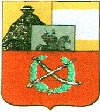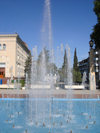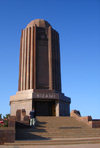 Ganca
(pronounced 'Ganja') is Azerbaijan's second largest city (population 300,000).
The city is located on the Ganca river, south of the Kura River in a rich
agricultural area. Ganca has for long been the main industrial centre of
western Azerbaijan. A heavy industrial heritage from Soviet times comprises
aluminium, porcelain, instrument making, furniture, textile and other factories
which are now mostly stopped, while new investment is slowly bringing new
plants to Ganca, usually with smaller scales companies.
Ganca
(pronounced 'Ganja') is Azerbaijan's second largest city (population 300,000).
The city is located on the Ganca river, south of the Kura River in a rich
agricultural area. Ganca has for long been the main industrial centre of
western Azerbaijan. A heavy industrial heritage from Soviet times comprises
aluminium, porcelain, instrument making, furniture, textile and other factories
which are now mostly stopped, while new investment is slowly bringing new
plants to Ganca, usually with smaller scales companies.
 The
city was the centre of the caucasian Albanian Christianity till the 11th
century, when it fell to the Seljuk Turks. It was rebuilt in the
12th century after an earthquake in 1139 destroyed the original town that
was founded in the 5th century, east of the modern city.
The
city was the centre of the caucasian Albanian Christianity till the 11th
century, when it fell to the Seljuk Turks. It was rebuilt in the
12th century after an earthquake in 1139 destroyed the original town that
was founded in the 5th century, east of the modern city.
Being located on the main caravan routes it became an important centre of trade but was again destroyed by a Mongol invasion in 1231. In the 15th century Ganca was included in the state of Garagoyunlu. In 16th century the town was taken by the Sefavids.
 Ganca
was part of the Persian Empire from 1606, as the capital of a khanate,
until the Russian Empire annexed it in 1804. Russian troops defeated Persian
forces here in 1826. Numerous Armenian, Russian and German settlers moved
to Ganca developing a significant industrial and commercial momentum.
Ganca
was part of the Persian Empire from 1606, as the capital of a khanate,
until the Russian Empire annexed it in 1804. Russian troops defeated Persian
forces here in 1826. Numerous Armenian, Russian and German settlers moved
to Ganca developing a significant industrial and commercial momentum.
For some time in 1918 Ganca was the provisional capital of a briefly independent Azerbaijan. Changes in history were also reflected on the city's name. The toponym 'Ganja' is not drug related... it originates in the Ganjak tribe. The city was named Elisavetspol from 1804 to 1918, after the wife of tsar Alexander I. It reverted to the name of Ganca until 1935, when it was renamed Kirovabad. It reverted to Ganca in 1989. In recent history Ganca was the scene of a military uprising in June 1993 that toppled the government of president Abulfaz Elchibey.
 The
road from Baku to Ganca is one of the country's most scenic. The area is
famous for the Kapaz mountain and the 7 lakes near it, particularly
the Geygel - the blue lake. The territory is perfect for canoeing,
swimming, walking and trekking or for the simple joys of a family pic-nic.
The
road from Baku to Ganca is one of the country's most scenic. The area is
famous for the Kapaz mountain and the 7 lakes near it, particularly
the Geygel - the blue lake. The territory is perfect for canoeing,
swimming, walking and trekking or for the simple joys of a family pic-nic.
 The
city was the birthplace of poets Abil-Ula, Mahsati hanum Ganjavi and Nizami
- is considered the country's literary centre. Today the Hassan Aliyev
University, the Academy of Sciences, Medical School and the Ganja State
University (formerly the Pedagogical Institute) ensure that the scholastic
tradition is continued. Ai all four state and two private higher educational
institutions function in the city with 24.000 students.
The
city was the birthplace of poets Abil-Ula, Mahsati hanum Ganjavi and Nizami
- is considered the country's literary centre. Today the Hassan Aliyev
University, the Academy of Sciences, Medical School and the Ganja State
University (formerly the Pedagogical Institute) ensure that the scholastic
tradition is continued. Ai all four state and two private higher educational
institutions function in the city with 24.000 students.
 With
ample streets and avenues and well designed parks, Ganca is prettier than
most Azeri towns. The city retains a strong German influence in its architecture.
(After the collapse of the Soviet Union; without travel restrictions; worried
about the war with Armenia, and with strong incentives from the fatherland,
most ethnic Germans left in the early 1990s.)
With
ample streets and avenues and well designed parks, Ganca is prettier than
most Azeri towns. The city retains a strong German influence in its architecture.
(After the collapse of the Soviet Union; without travel restrictions; worried
about the war with Armenia, and with strong incentives from the fatherland,
most ethnic Germans left in the early 1990s.)
 With
a vast main square, the city has its fair share of Soviet architecture,
some of it quite good, like the grand city hall with its immense
colonnade. Lenin's statue is now gone from the main square, but the city
retains a lot from previous times, both in architecture and in character.
With
a vast main square, the city has its fair share of Soviet architecture,
some of it quite good, like the grand city hall with its immense
colonnade. Lenin's statue is now gone from the main square, but the city
retains a lot from previous times, both in architecture and in character.
 Located
near Khatai street, in a park south of the main square you should not miss
the 17th century Shah Abbas, or Juma mosque, with two tall
minarets and a dome with interesting decoration. The red-brick building
was designed by scientist and architect Sheykh Baga-ud-din and is illuminated
through beautiful panels of stained glass (Shebeke). There are also a few
other less appealing mosques.
Located
near Khatai street, in a park south of the main square you should not miss
the 17th century Shah Abbas, or Juma mosque, with two tall
minarets and a dome with interesting decoration. The red-brick building
was designed by scientist and architect Sheykh Baga-ud-din and is illuminated
through beautiful panels of stained glass (Shebeke). There are also a few
other less appealing mosques.
The two-storied but rather modest caravanserai
can be found in the vicinity of Hotel Ganca. Nearby there is a colourful
mosaic, one more tribute to Nizami.
 Another
landmark is the first parliament of the short lived 'Azerbaijan
Democratic Republic', originally it was the city hall and is now used as
an agricultural school. Near the parliament is the large and pleasant city
park, comprising the remains of the 16th century fortress walls
and a chaikhana.
Another
landmark is the first parliament of the short lived 'Azerbaijan
Democratic Republic', originally it was the city hall and is now used as
an agricultural school. Near the parliament is the large and pleasant city
park, comprising the remains of the 16th century fortress walls
and a chaikhana.
 The
baths,
situated close to the Abbas mosque have striking colours and attractive
domes, but are not very old. Behind the baths there is the 19th century
grave of Javad Khan and across Ganca street you'll find the cinema. The
modern baths can be found a few blocks to the east.
The
baths,
situated close to the Abbas mosque have striking colours and attractive
domes, but are not very old. Behind the baths there is the 19th century
grave of Javad Khan and across Ganca street you'll find the cinema. The
modern baths can be found a few blocks to the east.
 Although
most Christians are now gone (Armenians, Russians and Germans) there are
several churches worth a visit: a ruined Armenian church in the
south of the town, the Alexander Nevski church (now the puppet theatre!)
and a 19th century orthodox church near the university. The state drama
theatre is on Abbaszade street and the state philarmony is on Atayev street.
Although
most Christians are now gone (Armenians, Russians and Germans) there are
several churches worth a visit: a ruined Armenian church in the
south of the town, the Alexander Nevski church (now the puppet theatre!)
and a 19th century orthodox church near the university. The state drama
theatre is on Abbaszade street and the state philarmony is on Atayev street.
 A
local oddity is the bottle house, a two-storey building decorated
with about 50.000 glass bottles! (intersection of Guseinli and Garia streets.)
The decorations contain a portrait of one of the family members, missing
since WWII / Great Patriotic War. North of the bottle house is the Mir
Bager Aga tomb.
A
local oddity is the bottle house, a two-storey building decorated
with about 50.000 glass bottles! (intersection of Guseinli and Garia streets.)
The decorations contain a portrait of one of the family members, missing
since WWII / Great Patriotic War. North of the bottle house is the Mir
Bager Aga tomb.
 If
you still have time try the history museum (Ataturk avenue, near
the city hall) or the academy museum (in front of the old parliament),
both are housed in early 20th century noveau riche mansions. For shopping
try browsing the central department store, on Nizami street.
If
you still have time try the history museum (Ataturk avenue, near
the city hall) or the academy museum (in front of the old parliament),
both are housed in early 20th century noveau riche mansions. For shopping
try browsing the central department store, on Nizami street.
Even some of the very recent architecture of Ganca is worth seeing, e.g. some of the banks. The local stadium is home to the Kapaz Ganca soccer team. The first goal of independent Azerbaijan in the European football competitions was made by the player of Kapaz team Y. Suleymanov.
 Outside
the city you'll find the ruins of old Ganca, they are located about
6 kms east of the centre near the road to Baku (after the semi abandoned
aluminium factory).
Outside
the city you'll find the ruins of old Ganca, they are located about
6 kms east of the centre near the road to Baku (after the semi abandoned
aluminium factory).
The ruins have little to see, and are hard to access because of a tank unit housed in the area, but it's worth visiting the nearby Nizami's mausoleum. The existing monument, built in 1991 replaces a similar obelisk dating from the late 1940s. The mausoleum is an elegant marble covered structure about 20 m tall. Behind it there is an open area with a display of scenes from Nizami's books, sculpted in metal.
 About
15 kms northeast of Ganca, after the village of Aznixi you'll find
the
Imanzade. This is a beautiful brick building with blue domes,
surrounded by a cemetery, that was built as the mausoleum of the 8th century
Imam Bagira ibn Ibrahim. Inside you'll find the tomb enveloped by black
curtains. The date of the original building is uncertain, and the current
design results mostly from a 19th century reconstruction.
About
15 kms northeast of Ganca, after the village of Aznixi you'll find
the
Imanzade. This is a beautiful brick building with blue domes,
surrounded by a cemetery, that was built as the mausoleum of the 8th century
Imam Bagira ibn Ibrahim. Inside you'll find the tomb enveloped by black
curtains. The date of the original building is uncertain, and the current
design results mostly from a 19th century reconstruction.
 There
are a couple of good restaurants in the city and several assorted other
places to eat. There is a Univermag north of the Academy of Sciences, but
if you prefer there is a large bazaar in the north-eastern sector of the
city.
There
are a couple of good restaurants in the city and several assorted other
places to eat. There is a Univermag north of the Academy of Sciences, but
if you prefer there is a large bazaar in the north-eastern sector of the
city.
Ore minerals extracted from nearby mines supply Ganca's metallurgical industries, which produce copper and alumina. There are porcelain, silk and footware industries. Other industries process food, grapes and cotton from the surrounding farmlands. Besides the agricultural school Ganca also has an agricultural experiment station and an institute dedicated to cotton research.
 Ganca
is served by the country's major east-west road and rail routes (both going
to Georgia). You can take a bus from Baku to Ganca, but the city
is also served by its own airport (airport code: KVD - tel. 60263
/ fax 61305). There are some international
flights operated by Imair
and Turan Airlines (office on 254 Artatur av. - tel 66000), which also
flies to Nakhchivan and flights to Baku with AZAL. Bus services also connect
Ganca with Iran and Turkey. There several trains from Baku, but
the station is 5km away from the city centre.
Ganca
is served by the country's major east-west road and rail routes (both going
to Georgia). You can take a bus from Baku to Ganca, but the city
is also served by its own airport (airport code: KVD - tel. 60263
/ fax 61305). There are some international
flights operated by Imair
and Turan Airlines (office on 254 Artatur av. - tel 66000), which also
flies to Nakhchivan and flights to Baku with AZAL. Bus services also connect
Ganca with Iran and Turkey. There several trains from Baku, but
the station is 5km away from the city centre.
 If
you need lodging try the new Planet Hotel, on the east side of town
off Baku road, not in the centre, but there are restaurants nearby. Alternatives
are the Ganja Hotel, very central, near the Academy of Sciences (Khatai
av.) and Hotel Kapaz, near Nizami's statue.
If
you need lodging try the new Planet Hotel, on the east side of town
off Baku road, not in the centre, but there are restaurants nearby. Alternatives
are the Ganja Hotel, very central, near the Academy of Sciences (Khatai
av.) and Hotel Kapaz, near Nizami's statue.
(300 km west of Baku)